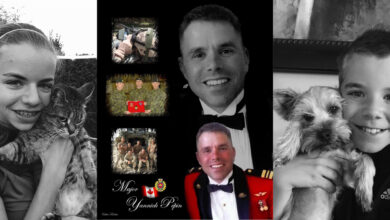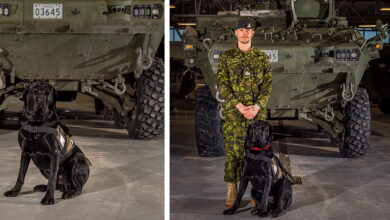Best of CMF Magazine
Imagery Techs Tell CAF Story
 Visually telling the story of the Canadian Armed Forces is not an easy job. Imagery Technicians sprawl in desert sand, hang from open doors of banking planes and freeze in snow covered tundra to capture troops in action. Imagery Technicians cover operations across Canada and internationally.
Visually telling the story of the Canadian Armed Forces is not an easy job. Imagery Technicians sprawl in desert sand, hang from open doors of banking planes and freeze in snow covered tundra to capture troops in action. Imagery Technicians cover operations across Canada and internationally.
Combat Camera is a section under the assistant deputy minister of public affairs, employing 20 military and civilian personnel in Ottawa. CAF imagery technicians and videographers are posted to Combat Camera from three environments; army, navy, and airforce.
“Our mission is twofold. They are to capture the CAF story for historical purposes including events, operations, missions, awards, and general interest. Essentially they capture photos that make a mark in Canadian history,” explained Captain Gabrielle Rousseau, Deputy Head Section, Canadian Forces Combat Camera.
The second component of the mission is to make the imagery of the CAF available to all media, who otherwise would not be able to access footage or photos due to their limited resources and the climate in which the images were captured, such as in theatre.
Combat Camera is a high readiness unit. Members and their families are prepared for the photographers and videographers to leave for varying periods of time, with four to eight hours notice.
When called up Combat Camera makes an effort to send one public affairs officer and two image technicians if there is room on the plane, helicopter, or piece of equipment they are travelling in.
“Image technicians take photos or videos in whatever location they are assigned. The public affairs officer accompanying the technicians acts as the producer of the shoot, making sure the images will be taken safely and the subject being captured is accurate. The data is then sent back to Combat Camera offices to be reviewed by photo editors,” explained Rousseau.
Then every photo must be captioned and catalogued accordingly. Once catalogued a public affairs officer must review the photo and caption for accuracy. At the present time, the CAF archives hold over 30,000 images taken by image technicians.
“The point of the entire process is to achieve a quality, not necessarily a quantity,” said Rousseau.
Once the images or videos have been taken in the field hours of processing has to take place.
“Our job is not done when the patrol is over and everyone is back to base. We have to then work on the pictures and get them where they need to go. We have to take care of our equipment as well. This can all take up to five hours, sometimes more,” said Rousseau.
Imagery technicians attend school in Borden, Ontario where they hone and fine tune their craft. The results of the trade are based on innate artistic skill and technology. Technicians regularly train throughout their career because technology is always improving.
Being an imagery technician can be dangerous. On operations, image techs carry not only their photography equipment, but weapon as well. They go on patrols, hang out of helicopters, cling to the decks of ships, and follow Canadian troops wherever the mission takes them, whatever is required to accurately tell the story of the CAF.









